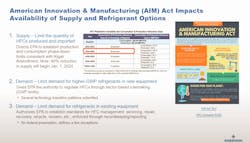As the phase-down of hydrofluorocarbon (HFC) refrigerants continues, heating, air conditioning and refrigeration contractors have a variety of information resources at their fingertips, including associations, manufacturers and distributors, to help them stay in step with this important HVACR industry change.
Among the manufacturers helping with critical information dissemination related to the phasedown is Emerson Commercial & Residential Solutions. Emerson recently presented a webinar on “The Latest in Refrigerant Rulemaking and Safety Standards,” hosted by Rajan Rajendran, Emerson's Global Vice President, Environmental Sustainability, and Jennifer Butsch, Regulatory Affairs Director for Emerson.
The presenters -- who are recognized across the HVACR industry from their activity as seminar presenters and contacts for contractors and distributors across North America -- covered four points:
- AIM Act & EPA
- Available Tools to Meet the HFC Phasedown
- State-level Activities
- Refrigerant Options.
Step 1 of the phasedown is to limit the quantity of HFC refrigerants produced and imported into the US.
The American Innovation & Manufacturing Act limits the metric tons supply of higher GWP (global warming potential) refrigerants produced and imported, in line with the Kigali Amendment.
- The phasedown began in January, 2022 with a 10 percent reduction.
- A 40 percent reduction in supply of those refrigerants will begin on January 1, 2024.
- By January 2029, production and importation will be reduced by 60 percent. By 2036, it will be reduced by another 15 percent.
Jennifer Butsch explained the method used to calculate refrigerant reductions:
“The quota takes the GWP of refrigerant multiplied by the quantity produced and you have X million metric tons of CO2.. Producers are given a value of how much they can produce or import relative to that number. So, if we move to lower GWP refrigerants they can produce more; if we continue to use higher GWP refrigerants they produce less. The price of refrigerant has been increasing this year, and as the quantity of supply decreases. We have to transition to lower GWP refrigerants, or the price of higher GWP refrigerants is expected to continue to increase," Butsch explained.
Step 2 is to limit demand for the higher GWP refrigerants in new equipment, by using sector-based rulemaking regarding GWP limits.
Step 3 is to limit demand for higher GWP HFC refrigerants in existing equipment. The EPA has been authorized by Congress to establish standards for HFC management related to servicing, repair, recovery, recycling, reclaiming, to be enforced through record-keeping and reporting.
“The AIM Act directs the EPA to try to balance supply and demand. They know that supply is decreasing, so we need to hold demand in line. The first is on newMore than 80 percent of refrigerant produced is allocated to the air conditioning, heat pump and refrigeration markets. However, 60 percent of that is used to top off refrigerant leaks.
Next, there is a need to reduce demand on the equipment service side, and to address demand required to charge existing equipment. Tactics to achieve that reduction might include a sharp focus on equipment leak reduction, verification and reporting, similar to that which was in play during the implementation of EPA Sec. 608 for HCFC refrigerants (R-22 and others).
“They could also go beyond that to include reclaim programs as well,” Butsch said. “We haven’t seen much action on this as yet, because EPA has been focused on implementing Steps 1 and 2. But I know they’re working on it and thinking about it, so it won’t be too long [before a decision is made].”
Related to Step 2 and how demand on new equipment might play out, Butsch said AMAC did ask for stakeholders to submit petitions to EPA. Petitions are primarily related to further restrictions on HFC applications.
“In October 2021 EPA did grant many of these petitions, so they’re now working on rule making. Hopefully we’ll see the draft rule for each sector roll out on how they plan to transition each sector," Butsch said.
Leak Reduction Critical
Rajendran shared information that showed more than 80 percent of refrigerant produced is allocated to the air conditioning, heat pump and refrigeration markets. However, 60 percent of that is used to top off refrigerant leaks. Only about 40 percent is going into new equipment.
Rajendran said following those steps will actually result in a reduction of refrigerant use below the target levels.
"When we look at how we are going to manage refrigerants going forward, as the HFC phasedown happens, we have to look at new equipment, and servicing of existing equipment in order to meet the HFC phasedown goals. Leak reduction, therefore is critical," Rajendran urged.
To reduce direct environmental impact, Rajendran said there are steps that can be taken related to both new and existing equipment:
1. For new equipment, use lower or as low as possible GWP refrigerants and consider smaller refrigerant charge sizes in design and selection.
2. For existing equipment, Rajendran advised:
- maintaining, detecting, fixing and reducing or eliminating refrigerant leaks
- retrofitting to a lower GWP refrigerant within the same refrigerant class
- consider preparing to use A2L (mildly flammable) refrigerants
- recovering and reclaiming refrigerant for servicing needs
- install, commission and maintain all components, equipment and systems to design conditions at all times.
Energy Savings Benefit
Rajendran reminded webinar listeners that energy reduction is another benefit that will come from the use of lower GWP refrigerants.
Transportation & Storage
Transportation and storage regulations for A2L and A3 refrigerants will be in force and will require diligent practices. Butsch said the Department of Transportation sent a letter of interpretation to the industry, confirming manufacturers, distributors and contractors are permitted to transport air conditioning and refrigeration equipment over ground containing up to 25 pounds (12 kg) of A2L and A3 refrigerants without the need for HAZMAT protocols.
Related to storage, cylinders of A2L and A3 refrigerant cylinders must be stored a minimum of 10-ft. away from flammable liquids that have secondary containment, and 20-ft. away from flammable liquids without secondary containment. (See table in the gallery for additional storage requirements.)
State Level Activity
Butsch provided a review of past and ongoing action by some states related to refrigerant limitations.
California
- the California Air Resources Board (CARB) has released a draft proposal seeking to achieve carbon neutrality as called for in SB 32. New construction would be zero-emission structures starting in 2026 for residential and commercial buildings. New space and water heating appliances sold in California would be all-electric by 2035 for residential dwellings, and by 2045 for commercial buildings.
- California Senate Bill 1026 proposes a ban on the sale of bulk hydrofluorocarbons or bulk blends containing HFCs.
- Beginning January 1, 2025, GWP shall not exceed 2,200.
- Beginning January 1, 2030, GWP shall not exceed 1,400
- Beginning January 1, 2033, GWP shall not exceed 750.
- CARB will make an assessment by January 1, 2025 on how to transition the state's economy away from HFCs and to ultra-low or no-GWP alternatives no later than 2035, through maximizing recovery and reclamation and increasing the adoption of new low (<150) and ultra-low GWP alternative refrigerants.
Washington
There is a proposal similar to existing California GWP limits in refrigeration and air conditioning:
- GWP in commercial refrigeration for new and existing facilities in 2025
- 750 GWP in 2024 chillers, and 2025 for air conditioners and heat pumps.
New York Scoping Plan
- Adopt zero-emission codes and standards and require energy benchmarking for buildings:
1. All-electric new construction in 2024 for single family/low rise buildings and 2027 for commercial buildings.
2. Prohibit oil and gas replacements of space and water heating equipment in 2030 for single family and low rise buildings; and by 2035 for commercial buildings.
3. Reporting whole-building energy and water consumption data for commercial (greater than 10,000 sq. ft. in 2023.
4. Require owners of single-family buildings to obtain and disclose an energy performance rating as part of sale listing in 2027.
5. Transition from HFC refrigerants.
Rajendran and Butsch shared the following resources that are available to keep contractors, manufacturers and distributors well-informed relative to refrigerant phasedown and transition:
- AHRI Webinars: https://ahrinet.org/news-events/webinars
- Emerson materials: https://climate.emerson.com/en-us/expertise/hvacr-regulations.
- Original equipment manufacturers are also resources.
- ACCA or HARDI
Additionally, Rajendran said the EPA will come forward with further rulemakings before the end of 2022, related to approval of A2L refrigerants in new applications, and possibly approve of new refrigerants.
"If you are a contractor, you need to spend the time between now and the next six months of this year to get better educated about this. Existing high-GWP refrigerants will become more expensive, and it will be extremely important to follow all proper practices related to refrigerant recovery, reuse and reclamation.
"Venting is not an option at all, period," he said.
'Have a deliberate, conscious plan to manage refrigerants as though they were very expensive assets, which is what they'll become, if they're not already.'- Rajan Rajendran.
"If I had R-22 equipment, I would not put in R-410A. Use a newer replacement, but it has to be approved by the equipment manufacturer. As we transition to flammable refrigerants, this becomes 10 times more important, because you're not only talking about equipment performance, you're also talking about safety. Therefore, you have to make sure that what you're putting in as a service replacement is indeed the refrigerant you're supposed to put in. Be diligent and careful," Rajendran cautioned.
Building Codes
"And, as Jennifer pointed out, many of these lower GWP replacements are highly flammable or mildly flammable, and therefore, building codes are changing. Following building code changes becomes extremely important," Rajendran said.
He also advised listeners to not over-think their strategy, because many have been through this before.
"Many know what they did during the transition out of R-22. This is not unlike that. Or, when we went from R-12 to R-22. Whatever your strategy was for dealing with that transition, this will be similar to that" Rajendran advised. "Have a deliberate, conscious plan to manage refrigerants as though they were very expensive assets, which is what they'll become, if they're not already."
About the Author
Terry McIver
Content Director - CB
As director of content for Contracting Business, he produces daily content and feature articles for CB's 38,000 print subscribers and many more Internet visitors. He has written hundreds, if not two or three, pieces of news, features and contractor profile articles for CB's audience of quality HVACR contractors. He can also be found covering HVACR industry events or visiting with manufacturers and contractors. He also has significant experience in trade show planning.


